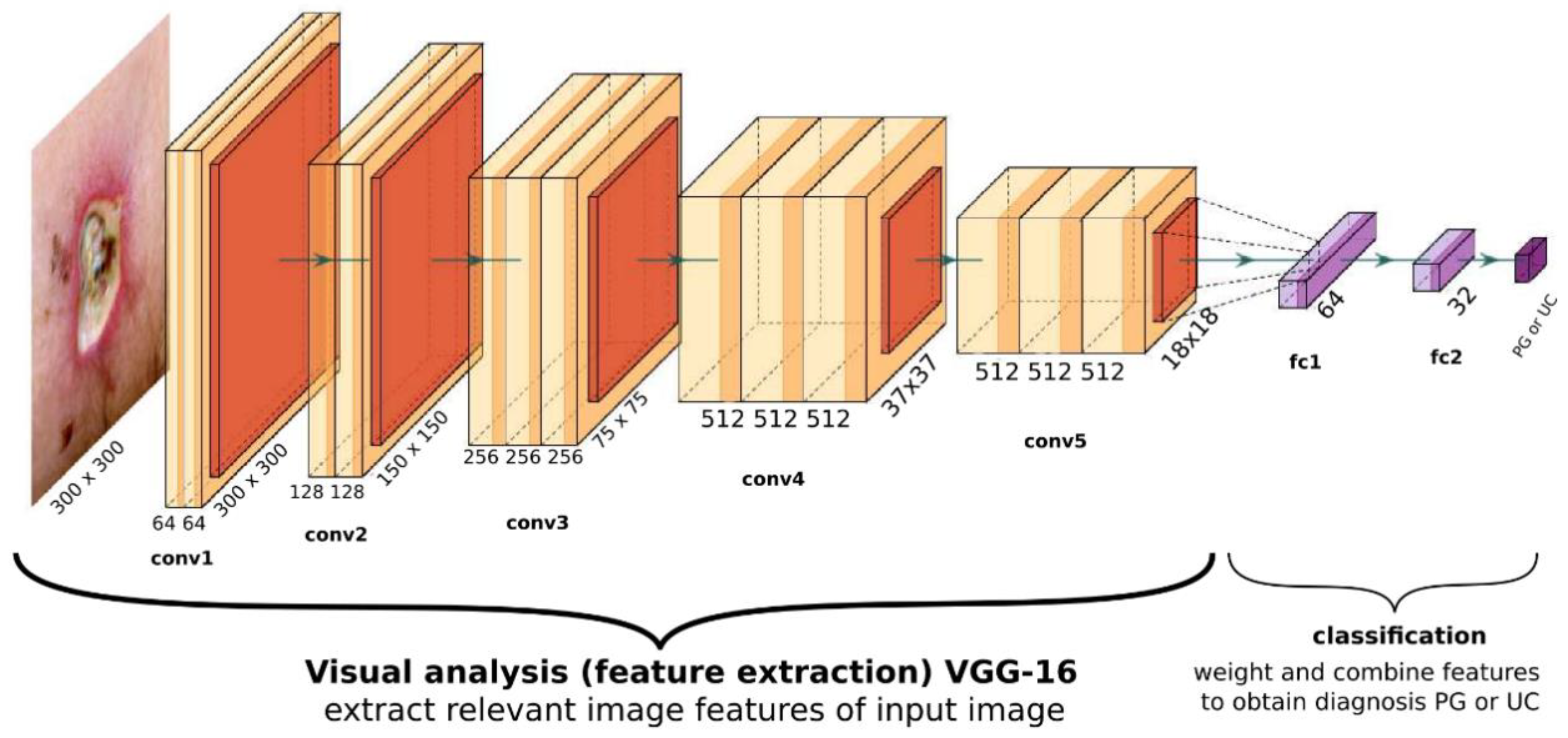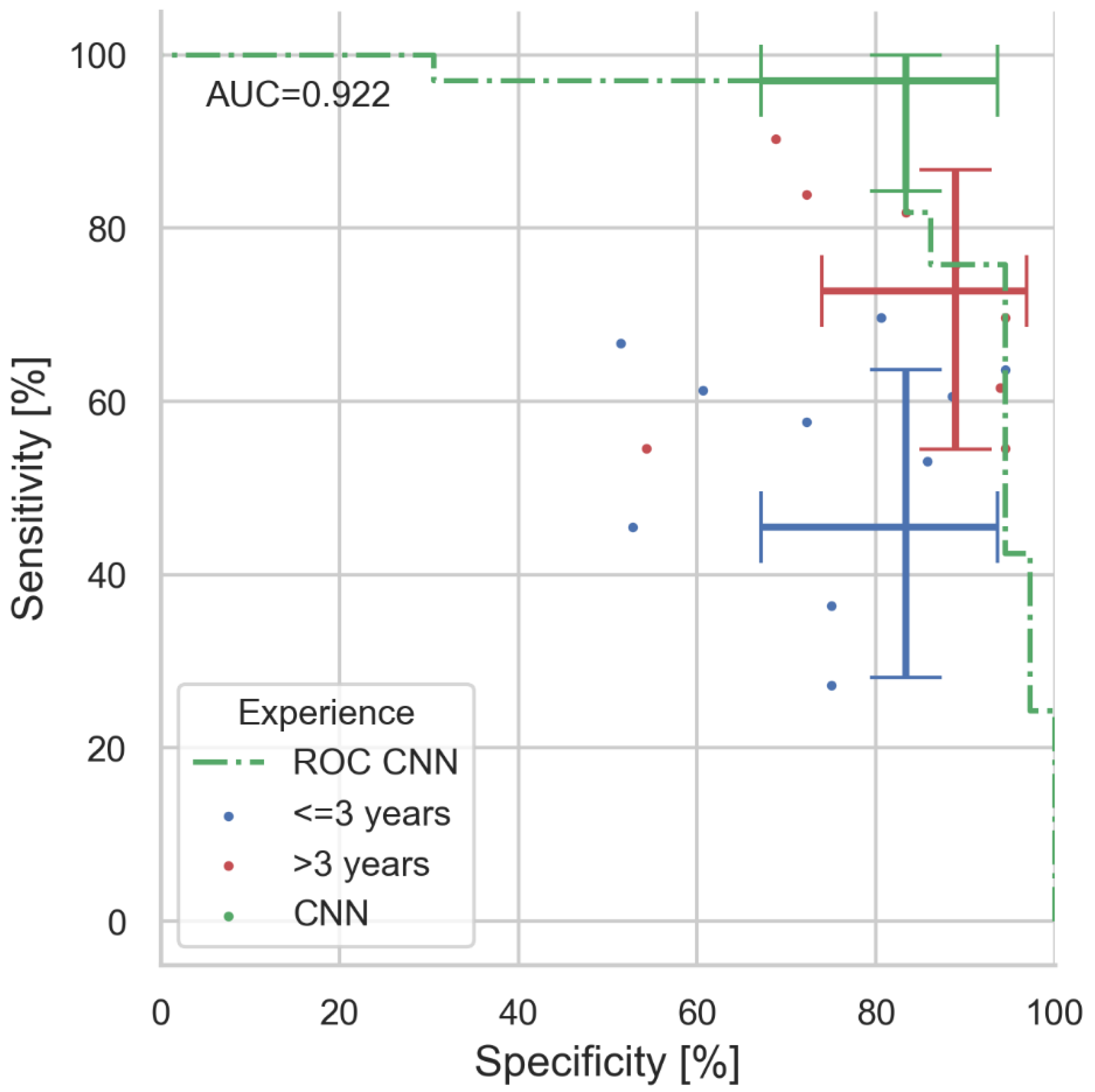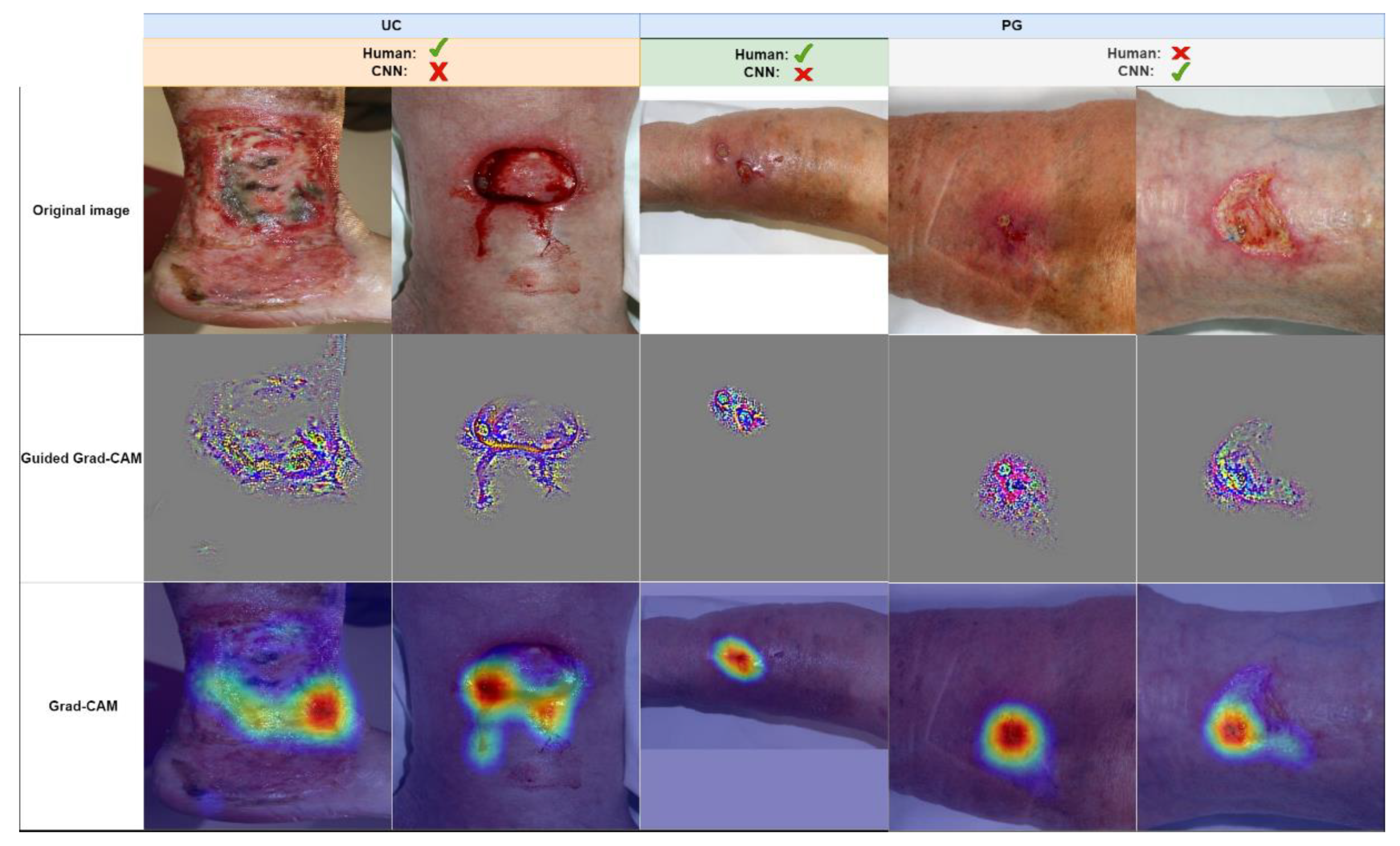Computer-Assisted Differential Diagnosis of Pyoderma Gangrenosum and Venous Ulcers with Deep Neural Networks
Abstract
1. Introduction
2. Materials and Methods
2.1. Data
2.2. Performance Measures
2.3. Convolutional Neural Network (CNN) Training
2.4. Exhaustive Grid Search for Optimal Model Design
2.5. Performance Validation
3. Results
3.1. CNN Optimization
3.2. Comparison with Human Specialists
3.3. Visualizing the Network’s View of the Wound
4. Discussion
4.1. Outlook
4.2. Limitations
Author Contributions
Funding
Informed Consent Statement
Data Availability Statement
Acknowledgments
Conflicts of Interest
References
- von den Driesch, P. Pyoderma Gangrenosum: A Report of 44 Cases with Follow-Up. Br. J. Dermatol. 1997, 137, 1000–1005. [Google Scholar] [CrossRef]
- Xu, A.; Balgobind, A.; Strunk, A.; Garg, A.; Alloo, A. Prevalence Estimates for Pyoderma Gangrenosum in the United States: An Age- and Sex-Adjusted Population Analysis. J. Am. Acad. Dermatol. 2020, 83, 425–429. [Google Scholar] [CrossRef]
- Langan, S.M.; Groves, R.W.; Card, T.R.; Gulliford, M.C. Incidence, Mortality, and Disease Associations of Pyoderma Gangrenosum in the United Kingdom: A Retrospective Cohort Study. J. Investig. Dermatol. 2012, 132, 2166–2170. [Google Scholar] [CrossRef]
- Al Ghazal, P.; Herberger, K.; Schaller, J.; Strölin, A.; Hoff, N.-P.; Goerge, T.; Roth, H.; Rabe, E.; Karrer, S.; Renner, R.; et al. Associated Factors and Comorbidities in Patients with Pyoderma Gangrenosum in Germany: A Retrospective Multicentric Analysis in 259 Patients. Orphanet. J. Rare Dis. 2013, 8, 136. [Google Scholar] [CrossRef]
- Ahn, C.; Negus, D.; Huang, W. Pyoderma Gangrenosum: A Review of Pathogenesis and Treatment. Expert Rev. Clin. Immunol. 2018, 14, 225–233. [Google Scholar] [CrossRef]
- Hobbs, M.M.; Ortega-Loayza, A.G. Pyoderma Gangrenosum: From Historical Perspectives to Emerging Investigations. Int. Wound J. 2020, 17, 1255–1265. [Google Scholar] [CrossRef]
- Quist, S.R.; Kraas, L. Treatment Options for Pyoderma Gangrenosum. J. Dtsch. Dermatol. Ges. 2017, 15, 34–40. [Google Scholar] [CrossRef]
- Brooklyn, T.N.; Dunnill, M.G.S.; Shetty, A.; Bowden, J.J.; Williams, J.D.L.; Griffiths, C.E.M.; Forbes, A.; Greenwood, R.; Probert, C.S. Infliximab for the Treatment of Pyoderma Gangrenosum: A Randomised, Double Blind, Placebo Controlled Trial. Gut 2006, 55, 505–509. [Google Scholar] [CrossRef]
- Ormerod, A.; Thomas, K.; Craig, F.; Mitchell, E.; Greenlaw, N.; Norrie, J.; Mason, J.; Walton, S.; Johnston, G.; Williams, H. Comparison of the Two Most Commonly Used Treatments for Pyoderma Gangrenosum: Results of the STOP GAP Randomised Controlled Trial. Br. Med. J. 2015, 350, h2958. [Google Scholar] [CrossRef]
- Song, H.; Lahood, N.; Mostaghimi, A. Intravenous Immunoglobulin as Adjunct Therapy for Refractory Pyoderma Gangrenosum: Systematic Review of Cases and Case Series. Br. J. Dermatol. 2018, 178, 363–368. [Google Scholar] [CrossRef]
- Eaton, P.A.; Callen, J.P. Mycophenolate Mofetil as Therapy for Pyoderma Gangrenosum. Arch. Dermatol. 2009, 145, 781–785. [Google Scholar] [CrossRef] [PubMed]
- Chatzinasiou, F.; Polymeros, D.; Panagiotou, M.; Theodoropoulos, K.; Rigopoulos, D. Generalized Pyoderma Gangrenosum Associated with Ulcerative Colitis: Successful Treatment with Infliximab and Azathioprine. Acta Dermatovenerol. Croat. 2016, 24, 83–85. [Google Scholar] [PubMed]
- Sardar, P.; Guha, P.; Das, N.K.; Gharami, R.C.; Majumdar, S.; Banerjee, D.; Banerjee, R. Ulcerative Pyoderma Gangrenosum in Mixed Connective Tissue Disorder: A Rare Association and Role of Azathioprine in the Management. Indian J. Dermatol. 2011, 56, 600–602. [Google Scholar] [CrossRef]
- Miranda, M.F.M. Pyoderma Gangrenosum Treated with Sulfasalazine and Dapsone. Indian J. Dermatol. Venereol. Leprol. 2002, 68, 160–161. [Google Scholar]
- Ciurea, A.M.; Guitart, J.; Brieva, J. Complete and Durable Clinical Response of Malignant Pyoderma to Tacrolimus in Combination with Dapsone and Prednisone. Arch. Dermatol. 2010, 146, 102–103. [Google Scholar] [CrossRef]
- Herberger, K.; Dissemond, J.; Brüggestrat, S.; Sorbe, C.; Augustin, M. Biologics and Immunoglobulins in the Treatment of Pyoderma Gangrenosum—Analysis of 52 Patients. J. Dtsch. Dermatol. Ges. 2019, 17, 32–41. [Google Scholar] [CrossRef]
- Kolios, A.G.A.; Maul, J.-T.; Meier, B.; Kerl, K.; Traidl-Hoffmann, C.; Hertl, M.; Zillikens, D.; Röcken, M.; Ring, J.; Facchiano, A.; et al. Canakinumab in Adults with Steroid-Refractory Pyoderma Gangrenosum. Br. J. Dermatol. 2015, 173, 1216–1223. [Google Scholar] [CrossRef]
- Horvath, L. The PARACELSUS score: A diagnostic score for pyoderma gangrenosum. Z. Rheumatol. 2019, 78, 789–790. [Google Scholar] [CrossRef]
- Jockenhöfer, F.; Wollina, U.; Salva, K.A.; Benson, S.; Dissemond, J. The PARACELSUS Score: A Novel Diagnostic Tool for Pyoderma Gangrenosum. Br. J. Dermatol. 2019, 180, 615–620. [Google Scholar] [CrossRef]
- Hafner, J.; Nobbe, S.; Partsch, H.; Läuchli, S.; Mayer, D.; Amann-Vesti, B.; Speich, R.; Schmid, C.; Burg, G.; French, L.E. Martorell Hypertensive Ischemic Leg Ulcer: A Model of Ischemic Subcutaneous Arteriolosclerosis. Arch. Dermatol. 2010, 146, 961–968. [Google Scholar] [CrossRef]
- Weenig, R.H.; Davis, M.D.P.; Dahl, P.R.; Su, W.P.D. Skin Ulcers Misdiagnosed as Pyoderma Gangrenosum. N. Engl. J. Med. 2002, 347, 1412–1418. [Google Scholar] [CrossRef] [PubMed]
- Hafner, J.; Buset, C.; Anzengruber, F.; Barysch-Bonderer, M.; Läuchli, S.; Müller, H.; Oleg Meier, T.; Ulmer, N.; Reutter, D.; Kucher, N.; et al. Leg ulcers (ulcus cruris): The frequent macrovascular causes. Ther. Umsch. 2018, 75, 506–514. [Google Scholar] [CrossRef] [PubMed]
- Du-Harpur, X.; Watt, F.M.; Luscombe, N.M.; Lynch, M.D. What Is AI? Applications of Artificial Intelligence to Dermatology. Br. J. Dermatol. 2020, 183, 423–430. [Google Scholar] [CrossRef] [PubMed]
- Blanco, G.; Traina, A.J.M.; Traina, C., Jr.; Azevedo-Marques, P.M.; Jorge, A.E.S.; de Oliveira, D.; Bedo, M.V.N. A Superpixel-Driven Deep Learning Approach for the Analysis of Dermatological Wounds. Comput. Methods Programs Biomed. 2020, 183, 105079. [Google Scholar] [CrossRef]
- Wang, C.; Yan, X.; Smith, M.; Kochhar, K.; Rubin, M.; Warren, S.M.; Wrobel, J.; Lee, H. A Unified Framework for Automatic Wound Segmentation and Analysis with Deep Convolutional Neural Networks. Annu. Int. Conf. IEEE Eng. Med. Biol. Soc. 2015, 2015, 2415–2418. [Google Scholar] [CrossRef]
- Lu, H.; Li, B.; Zhu, J.; Li, Y.; Li, Y.; Xu, X.; He, L.; Li, X.; Li, J.; Serikawa, S. Wound Intensity Correction and Segmentation with Convolutional Neural Networks. Concurr. Comput. Pract. Exp. 2017, 29, e3927. [Google Scholar] [CrossRef]
- Esteva, A.; Kuprel, B.; Novoa, R.A.; Ko, J.; Swetter, S.M.; Blau, H.M.; Thrun, S. Dermatologist-Level Classification of Skin Cancer with Deep Neural Networks. Nature 2017, 542, 115–118. [Google Scholar] [CrossRef]
- Tschandl, P.; Argenziano, G.; Razmara, M.; Yap, J. Diagnostic Accuracy of Content-Based Dermatoscopic Image Retrieval with Deep Classification Features. Br. J. Dermatol. 2019, 181, 155–165. [Google Scholar] [CrossRef]
- Brinker, T.J.; Hekler, A.; Utikal, J.S.; Grabe, N.; Schadendorf, D.; Klode, J.; Berking, C.; Steeb, T.; Enk, A.H.; von Kalle, C. Skin Cancer Classification Using Convolutional Neural Networks: Systematic Review. J. Med. Internet Res. 2018, 20, e11936. [Google Scholar] [CrossRef]
- Han, S.S.; Kim, M.S.; Lim, W.; Park, G.H.; Park, I.; Chang, S.E. Classification of the Clinical Images for Benign and Malignant Cutaneous Tumors Using a Deep Learning Algorithm. J. Investig. Dermatol. 2018, 138, 1529–1538. [Google Scholar] [CrossRef]
- Haenssle, H.A.; Fink, C.; Schneiderbauer, R.; Toberer, F.; Buhl, T.; Blum, A.; Kalloo, A.; Hassen, A.B.H.; Thomas, L.; Enk, A.; et al. Man against Machine: Diagnostic Performance of a Deep Learning Convolutional Neural Network for Dermoscopic Melanoma Recognition in Comparison to 58 Dermatologists. Ann. Oncol. 2018, 29, 1836–1842. [Google Scholar] [CrossRef] [PubMed]
- Brinker, T.J.; Hekler, A.; Enk, A.H.; Berking, C.; Haferkamp, S.; Hauschild, A.; Weichenthal, M.; Klode, J.; Schadendorf, D.; Holland-Letz, T.; et al. Deep Neural Networks Are Superior to Dermatologists in Melanoma Image Classification. Eur. J. Cancer 2019, 119, 11–17. [Google Scholar] [CrossRef] [PubMed]
- Anisuzzaman, D.M.; Wang, C.; Rostami, B.; Gopalakrishnan, S.; Niezgoda, J.; Yu, Z. Image-Based Artificial Intelligence in Wound Assessment: A Systematic Review. Adv. Wound Care 2021, 11, 687–709. [Google Scholar] [CrossRef] [PubMed]
- Deng, J.; Dong, W.; Socher, R.; Li, L.-J.; Li, K.; Fei-Fei, L. Imagenet: A Large-Scale Hierarchical Image Database. In Proceedings of the 2009 IEEE Conference on Computer Vision and Pattern Recognition, Miami, FL, USA, 20–25 June 2009; IEEE: Manhattan, NY, USA, 2009; pp. 248–255. [Google Scholar]
- Chollet, F.; et al. Keras. Available online: https://keras.io (accessed on 23 November 2022).
- Selvaraju, R.R.; Cogswell, M.; Das, A.; Vedantam, R.; Parikh, D.; Batra, D. Grad-CAM: Visual Explanations from Deep Networks via Gradient-Based Localization. Int. J. Comput. Vis. 2020, 128, 336–359. [Google Scholar] [CrossRef]
- Janda, M.; Soyer, H.P. Can Clinical Decision Making Be Enhanced by Artificial Intelligence? Br. J. Dermatol. 2019, 180, 247–248. [Google Scholar] [CrossRef]




| CNN | Majority All Dermatologists (n = 18) | Majority Experts (>3 Year) (n = 8) | Majority Juniors (≤3 Year) (n = 10) | ||||||||
|---|---|---|---|---|---|---|---|---|---|---|---|
| Result | 95% CI | Result | 95% CI | p-Value | Result | 95% CI | p-Value | Result | 95% CI | p-Value | |
| Sensitivity [%] | 97.0 | 84.2–99.9 | 72.7 | 54.4–86.7 | <0.025 | 72.7 | 54.5–86.7 | <0.025 | 45.5 | 28.1–63.6 | <0.001 |
| Specificity [%] | 83.3 | 67.2–93.6 | 88.9 | 73.9–96.9 | n.s. | 88.9 | 73.9–96.9 | n.s. | 83.3 | 67.2–93.6 | n.s. |
| Accuracy [%] | 89.9 | 80.2–95.8 | 81.2 | 69.9–89.6 | n.s. | 81.2 | 69.9–89.6 | n.s. | 65.2 | 52.8–76.3 | <0.001 |
Publisher’s Note: MDPI stays neutral with regard to jurisdictional claims in published maps and institutional affiliations. |
© 2022 by the authors. Licensee MDPI, Basel, Switzerland. This article is an open access article distributed under the terms and conditions of the Creative Commons Attribution (CC BY) license (https://creativecommons.org/licenses/by/4.0/).
Share and Cite
Birkner, M.; Schalk, J.; von den Driesch, P.; Schultz, E.S. Computer-Assisted Differential Diagnosis of Pyoderma Gangrenosum and Venous Ulcers with Deep Neural Networks. J. Clin. Med. 2022, 11, 7103. https://doi.org/10.3390/jcm11237103
Birkner M, Schalk J, von den Driesch P, Schultz ES. Computer-Assisted Differential Diagnosis of Pyoderma Gangrenosum and Venous Ulcers with Deep Neural Networks. Journal of Clinical Medicine. 2022; 11(23):7103. https://doi.org/10.3390/jcm11237103
Chicago/Turabian StyleBirkner, Mattias, Julia Schalk, Peter von den Driesch, and Erwin S. Schultz. 2022. "Computer-Assisted Differential Diagnosis of Pyoderma Gangrenosum and Venous Ulcers with Deep Neural Networks" Journal of Clinical Medicine 11, no. 23: 7103. https://doi.org/10.3390/jcm11237103
APA StyleBirkner, M., Schalk, J., von den Driesch, P., & Schultz, E. S. (2022). Computer-Assisted Differential Diagnosis of Pyoderma Gangrenosum and Venous Ulcers with Deep Neural Networks. Journal of Clinical Medicine, 11(23), 7103. https://doi.org/10.3390/jcm11237103







